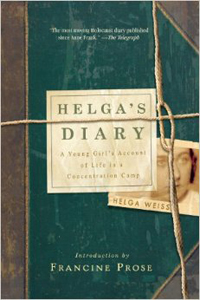Book Notes
 Helga Weiss, Helga's Diary; A Young Girl's Account of Life in a Concentration Camp (New York: W.W. Norton, 2013), 248pp.
Helga Weiss, Helga's Diary; A Young Girl's Account of Life in a Concentration Camp (New York: W.W. Norton, 2013), 248pp.
Helga Weiss was one of 15,000 children who were sent to the Nazi concentration camp at Terezín. Three and a half years later, in May 1945, she was one of about 100 who had survived. Although her father perished, her mother also survived. Today Weiss lives in the same Prague apartment in which she was born and from which she was deported.
Weiss was twelve when she and her parents were deported in December 1941. Her diary begins earlier, in 1938, just before the Germans invaded Czechoslovakia. In September of 1944, she was moved to Auschwitz, then on to Freiburg and Mauthausen. Before she left for Auschwitz, she gave her diary to her uncle, who worked in the records department. He hid the diary in a brick wall, then retrieved it after the war. Helga was 10 to 14 years old when she wrote the diary, but much of it, and the entire last part, were edited and reconstructed as an adult after the war.
The diary is in three parts — Prague, Terezín, and then Auschwitz, Freiburg and Mauthausen. Francine Prose has written an introduction to the book, and the translator Neil Bermel includes a lengthy interview with Weiss at the end of the book. Also included are selections of Weiss's artwork and archival photographs. "If you had not seen it with your own eyes, you would never believe it," she writes, "and one day even we will find it difficult to believe that people could live in such conditions." But thanks to this first-person account by someone who experienced it, we know exactly what happened to the 45,000 Jews who were living in Prague at that time.


